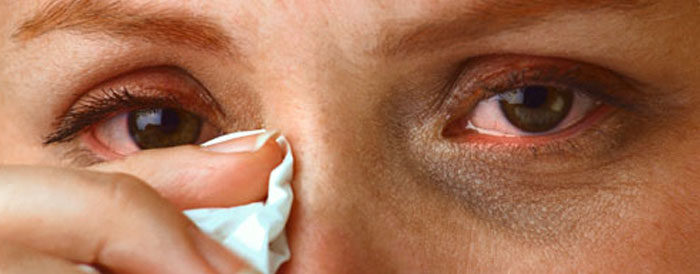
What’s causing your itching, teary eyes?
Do your eyes itch after you’ve been near a cat? Do they puff up or run with tears when pollen is in the air? Allergies of the eye affect about 20% of Americans each year, and are on the rise. The same inhaled airborne allergens – pollens, animal dander, dust mite feces, and mold – that trigger allergic rhinitis (the familiar sneezing, runny nose, and congestion) can lead to allergic conjunctivitis (inflammation of the conjunctiva, the lining of the eye). It’s not surprising that people with allergic rhinitis often suffer from allergic conjunctivitis as well.
About 50% of allergic conjunctivitis sufferers, who tend to be young adults, have other allergic diseases or a family history of allergies. About 80% of eye allergies are seasonal; the rest are perennial (year-round). The symptoms are itchy and red eyes, tearing, edema (swelling) of the conjunctiva or eyelid, and a mucous discharge. Although it can be uncomfortable, you can rest assured that it is not a threat to your vision.
Diagnosing allergic conjunctivitis
Allergic conjunctivitis usually can be confirmed by your doctor based on your symptoms. Testing is not usually needed to diagnose the condition, but skin testing (the same kind that’s done for other allergic reactions) may help identify the allergens causing your symptoms.
If your symptoms don’t quickly respond to treatment, see your doctor in case you have a different condition. Dry eye, in particular, can mimic the symptoms of allergic conjunctivitis.
Treating allergic conjunctivitis
Avoidance is your first line of defense. If you are allergic to cats, for example, avoid them (or at least don’t touch your eyes when near one), and wash your hands immediately after touching one. If pollen is your nemesis, keep your windows closed and an air purifier or air conditioner going in pollen season. Also, don’t rub your eyes, because rubbing causes cells in the conjunctiva to release histamine and other inflammatory chemicals, which worsens symptoms. Use artificial tears (available without prescription) frequently for relief and to dilute allergens in the eye.
If your only allergy problem is allergic conjunctivitis, then medicated eye drops would be your first step. You can start with an over-the-counter product, such as ketotifen eye drops (Zaditor, Alaway). The active ingredient is an antihistamine and a mast cell stabilizer, both of which can control the immune system overreaction that leads to your symptoms. Prescription-strength products that have similar actions are also available.
Allergic conjunctivitis can also be treated with over-the-counter oral antihistamines such as loratadine (Claritin), cetirizine (Zyrtec), and fexofenadine (Allegra), or the prescription antihistamines desloratadine (Clarinex) and levocetirizine (Xyzal). These are especially useful for people that have other allergy symptoms in addition to conjunctivitis.
For allergic conjunctivitis that is very severe and doesn’t improve with other medications, there are prescription eye drops that contain corticosteroids, such as loteprednol etabonate (Alrex, Lotemax) and fluorometholone (Fluor-Op, FML Forte). However, these eye medications should only be used under the guidance of your primary care physician or an ophthalmologist.
Source: Harvard Medical School

